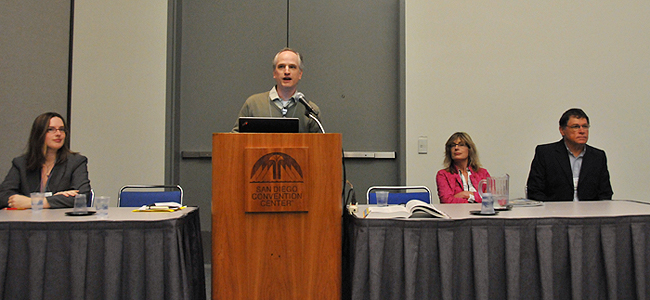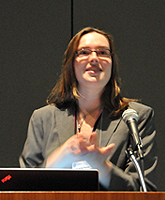American Psychological Association
118th Annual Convention
San Diego, August 12-15 2010

L-R: Acacia Parks; John Grohol, Chair; Helen Christensen, Azy Barak
Online Psychological and Mental Health Interventions
Following a brief introduction by Dr. John Grohol (PsychCentral.com), and apologies that one scheduled presenter was unable to be present, the panelists each described their own experience with online interventions, not only in terms of practice issues and technology within our society, but with some very impressive empirical findings to underscore just how positive results can be from using a rigorously researched program and design/implementation
of a platform upon which users might access a program or research study or self-help resource.
What was most striking to this psychologist is how much overlap there now seems to be between several formulations of "therapeutic" approaches, ranging from self-guided use of specific online tools or programs, to mediated online group experiences, to teaching "happiness" skills in an educative manner, derived from Seligman's work with "positive psychology".
The first speaker was Azy Barak, Ph.D., from University of Haifa, perhaps the most prolific author/researcher alive in the area of online applications and mental health activities, ranging from treatment and prevention programs to meta-analyses of the ever-increasing body of research relevant to online mental health activities.
Dr. Barak presented his recent research exploring salient factors in positive outcomes among support group members:
The Moderating Effect of Participants' Involvement in Online Support Groups

Azy Barak
Reviewing several studies and the wide variety of forms and applications of online support groups, Dr. Barak noted that in terms of effectiveness, in general "research shows that participants usually report of satisfaction and relief" following participation in online support groups. Such groups now exist widely all over the Internet, and are offered in response to a number of areas of distress, including but not limited to emotional, physical, social, medical and educational. Online support sites typically utilize "open forum" technology, but also take the form of chat rooms and e-mail lists. They may be unmoderated or have moderators, either professional or paraprofessional.
While there are differences depending upon the nature of individuals' particular area of distress or dysfunction, among the dynamics seen as exerting a powerful impact there are two major psychological mechanisms:
- The psychological effects of expressive writing (op. cit, the work of J Pennebaker); and
- Group process - following the classic dynamics described by Yalom.
In addition to the universal dynamics such as the development of group cohesion, online group processes which are clearly observable include universality, ventilation, mutual support and encouragement, advice giving and receiving, & learning.
In general the body of research shows that participants usually report satisfaction and relief, although debates continue (just as in psychotherapy outcome research into "traditional" f2f therapies") about "actual improvement" as validated by empirical indices of symptom reduction and lowered distress. [The old "effectiveness vs. efficacy" distinction!] While there is general agreement that participants in online support groups tend to experience an improved sense of empowerment and well-being, research also finds "personal differences" in experience of personal gain. Enter Azy Barak and colleagues.
Dr. Barak's series of studies have been oriented towards identifying exactly the nature of some of those differences, asking: "What are the reasons for the differences in research findings?" Not only are there differences between study findings, but also within groups within single studies.
Dr. Barak went on to describe a series of 4 studies, each using a different methodology and targeting a different population. The general hypothesis was that "level of participants' actual participation and engagement is related to their personal gains".
[MF - And we still need to learn *why* the most active netizens feel better. From holding court? having empathic feedback? Acting out? Rehearsing positive behaviors? Having social modeling? Having tons of objective support? Or is so much of the variance in results attributable to "personality" differences not so readily connected to our experience with Skinner boxes and BoBo dolls?]
Study #1: Adolescents in Severe Emotional Stress
The first study examined the level of online support group participation among adolescents experiencing severe emotional distress. This group was offered as a free, anonymous and open support group, in the form of a moderated forum. Twenty participants were surveyed after participating for at least 3 months. Each participant's level of participation was assessed by counting both messages and responses. In addition, three expert judges rated "level of distress" present in a sample of participants' messages.
Among the findings: "People who posted more messages in the first month felt better in the 2nd and 3rd months."
Study #2: Adolescents Experiencing Problematic Relationships With Their Parents
In the 2nd study - of adolescents with relationship problems with their parents - the support was provided using a moderated, closed, anonymous and free forum format. Forty-one participants were selected from a pool of 500, and agreed to participate in this research, which lasted for 10 weeks between pre-test and post-test, with Subjects completing self-reports before and after. Their number of messages and responses were also counted. As in the first study, the most significant findings were in relation to level of participation, as those with the most messages sent and received reported the biggest change in sense of "self image" (the strongest correlation to total messages posted) and also the sense of "social belonging" (the strongest correlation to total responses received). Both at a very strong significance level, (p<.001) - thank you Dr. Barak for sharing the data charts so I'm sure I'm seeing and reporting accurately!
Study #3: Adolescents Experiencing Social Isolation
Like the 2nd study, 44 participants were selected from the initial pool of 500, this group reporting high levels of social isolation: significant social problems such as shyness or painful loneliness. This too utilized a closed, anonymous, moderated forum format. Participants filled out a pre-test and post-test questionnaire, and as the other group, messages and responses were counted. Here the results were not significant in terms of changed "relationships with peers" (as self-reported), but there was a strong correlation between both sending and receiving messages and "self-image", "social belonging", and "social support".
[Hoping to see that one explained! Maybe that's a reflection on defining one's goals - and the experience was positive and self-efficacy building, even if it didn't change a sense of overall peer relationship improvement through group participation.]
Study #4: Comparison among Helped, Un-helped, and Neutral Participants in Various Online Support Groups
The fourth study involved 60 participants who were active with one of 46 online support groups for at least 3 months. Three groups of 20 each were identified, representing group members who explicitly stated they had been helped by their group, those who explicitly stated they were not helped by the group, and 20 who did not state anything about being helped or not by the group. In exploring the difference between these 3 groups, number of messages and responses were counted, as well as number of words and emoticons.
The findings were that members generally reported the experience had either "helped" or been neutral, with those who found it helpful being those who posted and received many more messages, and wrote more words, than others.
[I wonder about whether the extent they were acknowledged/supported is a large factor, as opposed to (or in addition too) benefiting from the chance to express oneself in words.]
Dr. Barak underscored how level of participation needs to continue being closely studied, as it seems to relate to outcome, at least in these studies. In conclusion he asserted that across populations and methodologies, "results clearly show that involvement, engagement, and activity level - as reflected by active writing and interacting - are related to personal gain achieved through participation in online support groups." He noted that some research suggests even "lurkers" might benefit from their listening in, but in general he advises that moderators encourage active participation. Finally, he thinks that future research into online support group outcomes should also include participants' activity level as a moderator.
Q&A
Dr. Barak now took some questions:
Question #1 was about the role of motivation in continued participation, and Dr. Barak agreed this was an important dynamic, and related to the notion of "therapeutic alliance".
Question: Any impact of the severity level of presenting problems on outcome?
Answer: Didn't find any [in these studies]
Q: The moderators/group leaders who you called "paraprofessionals". What was their training?
A: All had at least masters' degrees in psychology or related subject, plus special training.
Q: Was there an effect relating to the group leader's training?
A: Not as relevant an impact as the whole experience.
Q: And what might be one of the key factors arising from the experience?
A: Motivation
Q: Are you saying participation level is the most important thing?
A: I guess that participation is not the ONLY factor which influences outcome, but this is what we focused on.
![[color line]](http://www.fenichel.com/moveline.gif)
The second speaker today was Helen Christensen, Ph.D., from Australia, whose impressive work with the Mood Gym and automated online CBT-based programs dates back to 2001.
Dr. Christensen's presentation flowed nicely from Dr. Barak's describing several shared aspects of research into online health treatments and client utilization (e.g., motivation/reinforcement as well as outcomes). She has been exploring quite a broad array of factors in online help-seeking factors, as reflected in the title of her presentation:
The Role of the Internet in Encouragement of Help Seeking, and Prevention
Helen Christensen, Centre for Mental Health Researcher UNU Canberra, Australia

Dr. Christensen began by expressing her great joy to be back in San Diego, which she's dreamed of since a brief visit 22 years ago. And then, into the heart of what she's learned since the launching 9 years ago of the Internet based Mood Gym:
To begin with, as some context, Dr. Christensen noted that today approximately 40% of depression sufferers and 74% of those with anxiety problems "do NOT receive evidenced-based help". ["Evidence based" is now a very hot term being used everywhere in the health/mental health fields, but sometimes "evidence" is not so easy to interpret or apply.
You can see a discussion about this exact topic here
.]
The "gist" of evidence important to share includes research findings that suggest automated e health applications can be effective in the treatment of depression and anxiety, as well as in prevention.
It seems clear that a need is there, for some type of treatment option for a great many people, but "clinical services cannot meet the demand". At the same time it is clear that "prevention is critical". These and other factors argue strongly for systemic approaches.
The Mood Gym, Dr. Christensen continued, has both understood and added to the research base that suggests that CBT (cognitive behavioral therapy) approaches can be shown as effective (i.e., "evidence based") across settings, and also be effective as part of an online ehealth system. The Mood Gym (with which I have no affiliation!) looks very sophisticated in terms of the actual user experience. The audience was given a virtual tour highlighting how the site offers a secure, confidential environment where users can monitor their own progress over time, all the while also offering a "portal for researchers". More than a dozen research projects have been done or are now underway @ the Mood Gym.
So what does the evidence suggest might be advantages of a CBT-based online program which is either self-directed or supported? On a practical level there are the large benefits of access, cost, volume etc., for providers. But what about benefits for users?
Dr. Christensen referred to a graph of positive effects for what she dubbed "personal psychotherapy online - admittedly, somewhat paradoxical" and not what some may envision as typical psychotherapy.
Several studies have found value in online treatments for the most common and most commonly underserved difficulties where relief might be sought online. On depression trials one study found an effect size of .08-1.1, A study on anxiety (Spence, 2006) found some value in psycho-educational approaches to panic disorder. With social phobia treatment, there has been a strong effect size as well. In sum, depression interventions had the strongest response to intervention, but there were positive effects attributable to online interventions for generalized anxiety, panic disorder, and also social anxiety disorder.
Which gets to the question one might be asking, about whether the Mood Gym is completely self-guided or therapist guided. (It is many things, actually.) A key question in research has been, "Do you need guided therapy or will self-help yield the same results?" If the self-guided, CBT-based treatments are shown to be as effective/efficacious as f2f therapy sessions, then it follows that this is quite cost-effective. So they did a study on cost-effectiveness, and did a comparison which found that the cost may be the same, in term of unit price overall. But, with automated systems what happens is there is a high startup cost, and the cost per-person is very low. Once you are at a point of serving 3000 people, it comes
out to something like 5 cents per person! (She made the analogy to making a movie DVD - huge initial cost in the production, marketing, etc, and then the actual DVD's sold in the thousands or millions cost just a few cents to make.)
Dr. Christensen presented a map of the world, color-coded with users of the Mood Gym training program, illustrating 300,000 users from 203 countries worldwide: almost all of the world except a small part of West Africa. In addition to registered users, the site has about 37,000 visitors each month. Now, back to research.
A study was done in Australia, with 30 schools across the country, including in Aboriginal areas. (56% female, 17% living on a farm or rural area, mean age =14.33, 30% previously diagnosed as depressed, 34% having sought help from doctor/counselor). Following implementation of the program, there was at 6 months follow-up a significant result: reduction in depression, for boys. Girls seemed about the same. With anxiety, there was a positive impact on both boys and girls.
[Could it be that "depression" did not respond to automated intervention because females, distinct from males, tend to cope through seeking social support rather than activity or escape?]
Barriers to Prevention Program Participation
Aside from treatment, it was hoped that program participation among basically healthy children might have a preventive value. They now know that for these children, those that were healthy at pre-test remained healthy - 6 months later.
So how do you prove the preventive value? To do this you need healthy subjects to follow over time, as well as those with difficulties who can be tracked for improvement. Compare with a control group and it might be a powerful study.
There turned out to be several barriers.
First: Engagement. "How do you get young people who are well to participate in a prevention program?" Younger people tend to dislike doctors, feel just fine, and are unlikely to see themselves "at risk". They may also feel stigmatized. Or be too dysfunctional to participate or simply not engaged. Perhaps there is an alternative? Do these teens need evidence? Basically it is felt that "giving information is not enough".
At the same there is much evidence to support the power of social networking and "info-tainment" (e.g., YouTube) among many young people and it must be acknowledged how very powerful - and engaging - the Internet can be." The presence of incentives can be quite engaging too.
Barrier #2: Acceptance. "Some people feel 'prevention doesn't help'". There has been resistance among professionals in unexpected ways, too, such as attacks based on the feeling that self-help programs based on CBT will be "bad for real CBT". Still others conclude it is suspect or "unproven", etc.
Barrier #3: Adherence. The dropout rate has actually been "not as bad" as expected, given that up to 70% of patients drop out of face to face therapy. One finding which dovetails on Dr. Barak's closing comments on the value of moderation, is that "open" (membership) online sites have higher dropout rates.
Barrier #4: Safety - People believe that it is "not safe on the Internet"
The Beacon Project
Dr. Christensen introduced us to the Beacon Project.
Their site offers a user-friendly web interface, replete with smileys, and has been targeted at helping stress, PTSD, and Social Anxiety Disorder. One of the underlying assumptions of the developers is that it is possible to not only create a useful quality site but to create algorithmic rating tools - which can be automated - to quickly assess the value of a given web resource. This can be very useful if presenting a large compendium of web resources, and help to "identify and yield high quality websites."
Finally, Dr. Christensen repeated her belief that automated approaches might provide an effective tool to help people "immunize" against developing disorders.
![[color line]](moveline.gif)
Next up is Acacia Parks, Ph.D., who was a student of Martin Seligman at University of Pennsylvania and who continues to research the development of "happiness" and work within the framework of "positive psychology", including at the UP Positive Psychology Center.

Dr. Parks began by explaining that much of the research being done [on facilitating happiness through positive psychology approaches] relates to people with "sub-clinical depressive symptoms", a large population given that this symptom constellation is "just as common as major depressive disorder" (MDD).
This sub-clinical group also may be at risk for MDD.
Dr. Parks is currently conducting a study which is based on the understanding that there is a significant population online looking to improve their "mood", but presenting at a sub-clinical level. Unlike Dr. Christensen, her view is that CBT is not the direction where online intervention systems need to be headed. She mentioned two large studies of CBT, one at U of P and one at KPCHR (Kaiser-Permanente), both finding apparent effects, but of small magnitude (using the Beck Inventory). The components of the intervention were described as time-intensive and costly formats.
Here is "why I think cognitive behavioral approaches may not be best for a great number of people online", Dr. Parks continued.
First, there is the question of how to entice or motivate people to actively participate. No interest, unlikely utilization. The U of P study found that when offered a group intervention with an optional web supplement, "almost nobody used the online supplement".
Secondly, regarding CBT, "we just don't know" and it doesn't seem right therefore to just proceed with "psychology as usual - what's the problem and how can we fix it?" In contrast, Dr. Parks asserted that a positive psychotherapy (PP) approach yields the benefit of a positive emotional experience and fosters resilience. It can counter depressive problems without the need to label a disorder. And to counter anyone's worries about the potential for ignoring serious risk, we were reminded that these are sub-clinical populations, not actively suicidal.
Why the PP approach is ideal for this population:
Effectiveness:
Seligman, Rashid, and Parks (2006) found preliminary evidence of effectiveness for the PP approach. "It works [using] techniques for increasing happiness, not treating depression."
Motivation:
Additionally, there is the factor of motivation [which echoed Drs. Barak and Christensen in their description of "engagement"] (op cit Haidt 2002, 2004) Dr. Parks' observation is that "It improves with learning through positive psychotherapy."
Stigma:
"People may be more willing to pursue happiness than seeking to fix a problem."
Implementation of a PP program, finally, is said to be relatively easy.
Next Seligman's (2002) notions of the "3 Routes to Happiness" were presented: Pleasure, Engagement, and Meaning. (Here engagement refers to absorption in an activity, like a hobby. Meaning refers to "connection to something larger than oneself".)
Pleasure also has 3 aspects, emotions about past, present and future (Seligman, 2002). The "Flow Concept" was also briefly mentioned.
[Seligman/PP fans can find additional reports from past APA conventions where Seligman and others review the studies and philosophy.]
There has been a recent study, with participants recruited through Seligman's website (authentichappiness.org) , and undergoing a 6-week program consisting of completing 6 different exercises "targeting very different aspects of happiness", and done online, using a "buffet" of homework assignments. [Doesn't this sound just a tiny bit like a CBT approach? Yet a key philosophical difference seems to be the cognitive framing of learning happiness vs. treating an illness/problem.] The program involves "maintenance" of learned positive thinking tools, as well.
In what Dr. Parks presented as an Outline of Positive Psychotherapy, she presented the six exercises which involve targeting pleasure, engagement, and meaning:
- 3 Good Things
- Using your Strengths
- Gratitude Visit
- Active-Constructive Responding
- Savoring
- Life Summary
Dr. Parks described some very dense data analyses of a study where 661 self-help seekers were recruited through authentichappiness.org . Although well designed and with a strong number of Subject/participants, and built-in mechanisms to follow Subjects over time (1 year) findings are limited thus far in terms of definitive results, although promising. Dr. Parks noted how there have been additional considerations being generated through recognition of the initial study's limitations.
For example, what might be lacking in terms of engagement is that the current online format is not interactive, it lacks a sense of community or group, and the distance may mean "less accountability". Finally, like Dr. Barak, Dr. Parks has some questions which emerge from the literature thus far, and beg for further research. She would like to look at individual factors, such as the exercises and explore which seem to be most effective. She's also like to get some baseline data on symptoms, happiness beliefs, and look more closely at person-activity fit.*
[* I just love the latter term, as my own dissertation, 25 years ago, was titled "person-therapy fit" and led to a lifetime of interest in the same question: what works best for whom, in what situations, as the mantra of psychotherapy outcome research goes.]
.
Future directions include studying aspects of people's beliefs about "the nature of happiness" and "person activity fit".
In conclusion, great potential is seen for online application of what Dr. Parks dubs "positive psychotherapy", although she uses this term pointedly and was quick to point out that in fact this therapeutic endeavor is seen as teaching happiness rather than un-teaching mild depression through traditional open-ended (or CBT system) psychotherapies.
![[color line]](moveline.gif)
John Grohol spoke briefly and shared some observations about the present landscape as had been discussed. Finally, he engaged the panel in some final questions and a Q & A with the audience.

Dr. Grohol is well known, among his many accomplishments, as the founder of PsychCentral.com, co-founder of ISMHO.org, and observer/promoter of online mental health applications and activities for the past 15 years. He began with a few salient statistics illustrating the extent to which people turn to the Internet
35% of US adults now use social media for health and medical purposes ; Fully 40% of US adults online search for health information, each month. (Fox 2009, Pew Internet and American Life Project)
Presenting a timeline, Dr. Grohol traced Internet history from the 1990s into the 2000's, with more interactivity being taken advantage of with the rise of Facebook and MySpace, for example. In 2001, Mood Gym was launched (and today has 300,000 users). In the 2010's, it remains to be seen "what will catch users attention next" [op cit Jan Bergrstrom, the absent panelist, and colleagues, with research demonstrating the benefits of guided Internet CBT] And then there are exciting developments such as the evolution of the Beacon database, offering portals now into 90 programs. (Some are restricted, for example in the UK, where some treatments require prescriptions).
Dr. Grohol concluded by opening up a Q&A session, beginning with a question of his own about "adherence" (similar to "engagement"). Dr. Christensen mentioned how her study had used an iPhone as an incentive, with the added benefit that it required participation and the iPhone-submitted feedback was automatically tallied.
Dr. Barak was asked about the value and power of support groups in general and responded that "it's a question of expectations" and that "more guidance" appears helpful, along with feedback, such as many now are accustomed to with FB apps.
Dr. Grohol asked, should we then "be reaching out more to where people are", e.g., looking towards FB applications rather than focusing on driving people to our own sites? Dr. Parks agreed with reaching out to where the users are, and repeated that using a tool like an iPhone can be enticing - "get a free iPhone but answer 3 questions a day".
Question (from audience): Where do clinicians fit into this world? Are these things supplements? Are these interventions only for the 80% who would never seek intervention f2f?
And we end with such questions to ponder, along with reflections on the promising results being seen thus far.
![[color line]](http://www.fenichel.com/moveline.gif)
INDEX OF 2001 APA Convention Articles:
Behavioral Telehealth | E-biz of Mental Health | 2001: A Cyberspace Odyssey
INDEX OF 2002 APA Convention Articles:
CyberSex & Cyber-Infidelity | Beck & Ellis 2002 | Behavior Therapy | CyberPsychology | E-Ethics
2003 Convention Highlights:
Full Text | Beck 2003 | Quality of Online Health Info | Sternberg's Vision
2005 Convention Highlights:
Opening Session | Pioneers of Behavior Therapy
Distinguished Elders of Psychotherapy | Legends Discuss Psychology | Online Clinical Work | Town Hall Meeting
2006 Convention Highlights:
Opening | Online Psychotherapy & Research
| Psychological Vital Signs
|
Advances in Cognitive Therapy
Brok on Chaplin |
Conversation with Aaron T. Beck - 2006 | Dr.Phil |
21st Century Ethics | Media: Town Hall '06
2007 Convention Highlights:
Humanizing an Inhumane World | Opening Session
| Albert Bandura |
Linehan, on Suicide
Psychology's Future | Conversation with Aaron T. Beck - 2007 | Evil, Hate, & Horror
2008 Convention Highlights:
Grand Theft Childhood | Opening | Malcolm Gladwell
| College Success, Love, Hate, More |
My Life With Asperger's
My Space, You Tube, Psychotherapy, Relationships... | Aaron T. Beck - 2008 | The Mind and Brain of Voters
2009 Convention Highlights:
Internet: Pathway for Networking, Connecting, and Addiction | Opening | Virtual Psychology & Therapy
| Q&A with Zimbardo
Seligman: Positive Education | Future of Internet Media | Sex, Love, & Psychology |
How Dogs Think
2010 Convention Highlights:
Online Support Groups & Applications |
Evidence & Ethical Practice | Opening Ceremony | Sir Michael Rutter: Resilience
Group Memory | Psychology in the Digital Age | Steven Hayes: What Psychotherapists Have that the World Needs Now
![[color line]](moveline.gif)
![[Back to APA 2010 Presentations]](http://www.fenichel.com/back.gif) CURRENT TOPICS in PSYCHOLOGY Q&A Teaching Tools APA 2000 2001
2002 2003 2005 2006 2007 2008 2009
CURRENT TOPICS in PSYCHOLOGY Q&A Teaching Tools APA 2000 2001
2002 2003 2005 2006 2007 2008 2009
Current Topics in Psychology Copyright ©1996-2022 Michael Fenichel
Last Updated: Tuesday, 27-Dec-2022 23:37:30 EST




![[color line]](http://www.fenichel.com/moveline.gif)

![[color line]](moveline.gif)

![[color line]](moveline.gif)
